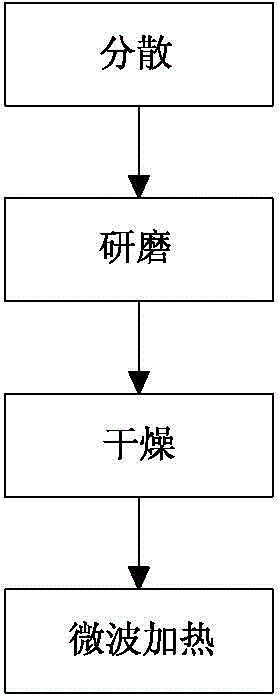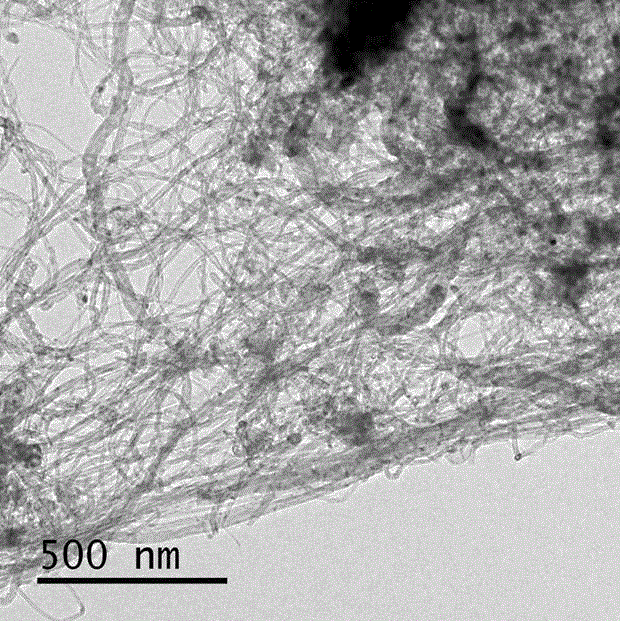Method for preparing composite cathode material of silicon-carbon nanotube of lithium ion battery
A nanotube composite and lithium-ion battery technology, which is applied in the field of lithium-ion battery silicon-carbon nanotube composite anode material preparation, can solve the problems of easy-to-destroy raw material morphology and high energy consumption
- Summary
- Abstract
- Description
- Claims
- Application Information
AI Technical Summary
Problems solved by technology
Method used
Image
Examples
preparation example Construction
[0022] Please refer to figure 1 As shown, it shows a preparation process of a lithium-ion battery silicon-carbon nanotube composite negative electrode material preparation method of the present invention, including the following steps:
[0023] (1) Dispersion: Disperse nano-silicon, dispersant, carbon source and catalyst in a solvent, and ultrasonicate for 0.5-2 hours to obtain a mixed slurry. The mass ratio of carbon source and nano-silicon is 0.2-5:1, and the catalyst dosage is nanometer 0.5% to 2% of the mass of silicon, and the amount of dispersant is 0.5% to 1% of the mass of nano silicon; the particle size of the nano silicon is 50 to 200 nm; the dispersant is polyvinylpyrrolidone, polyethyleneimine or One or more of sodium lauryl sulfate; the carbon source is glucose, sucrose, phenolic resin, furfural resin or high-temperature pitch; the catalyst is nickel nitrate, nickel sulfate, ferric nitrate, ferrocene or nano One or more of iron; the solvent is one or more of abso...
Embodiment 1
[0029] (1) Dispersion: Disperse nano-silicon, dispersant, carbon source and catalyst in a solvent, and ultrasonicate for 0.5h to obtain a mixed slurry. The mass ratio of carbon source and nano-silicon is 0.2:1, and the amount of catalyst is 1 / 2 of the mass of nano-silicon. 0.6%, the amount of dispersant is 0.8% of the nano-silicon quality; in the present embodiment, the particle diameter of the nano-silicon is 100 nm; the dispersant is polyvinylpyrrolidone; the carbon source is glucose; the catalyst It is nickel nitrate; the solvent is absolute ethanol.
[0030] (2) Grinding: Grind the mixed slurry with a sand mill for 2.5 hours at a grinding speed of 1000 r / min, then add solvent to adjust the solid mass content of the mixed slurry to 30%;
[0031] (3) Drying: Dry the ground mixed slurry into powder using a spray dryer. The air inlet temperature of the spray drying is 220 ℃, the air outlet temperature is 145 ℃, and the rotation speed of the constant flow pump is 78r / min;
[0...
Embodiment 2
[0034] (1) Dispersion: Disperse nano-silicon, dispersant, carbon source and catalyst in a solvent, and ultrasonicate for 0.8h to obtain a mixed slurry. The mass ratio of carbon source and nano-silicon is 1.5:1, and the amount of catalyst is 1 / 2 of the mass of nano-silicon. 1.2%, the amount of dispersant is 0.7% of the nano-silicon quality; in the present embodiment, the particle diameter of the nano-silicon is 150 nm; the dispersant is polyethyleneimine; the carbon source is sucrose; The catalyst is nickel sulfate; the solvent is ethanol.
[0035] (2) Grinding: Grind the mixed slurry with a sand mill for 2 h at a grinding speed of 1200 r / min, then add a solvent to adjust the solid mass content of the mixed slurry to 20%;
[0036] (3) Drying: Dry the ground mixed slurry into powder using a spray dryer. The air inlet temperature of the spray drying is 150 ℃, the air outlet temperature is 115 ℃, and the rotation speed of the constant flow pump is 80r / min;
[0037] (4) Microwave he...
PUM
| Property | Measurement | Unit |
|---|---|---|
| Particle size | aaaaa | aaaaa |
| Particle size | aaaaa | aaaaa |
| Particle size | aaaaa | aaaaa |
Abstract
Description
Claims
Application Information
 Login to View More
Login to View More - R&D
- Intellectual Property
- Life Sciences
- Materials
- Tech Scout
- Unparalleled Data Quality
- Higher Quality Content
- 60% Fewer Hallucinations
Browse by: Latest US Patents, China's latest patents, Technical Efficacy Thesaurus, Application Domain, Technology Topic, Popular Technical Reports.
© 2025 PatSnap. All rights reserved.Legal|Privacy policy|Modern Slavery Act Transparency Statement|Sitemap|About US| Contact US: help@patsnap.com



